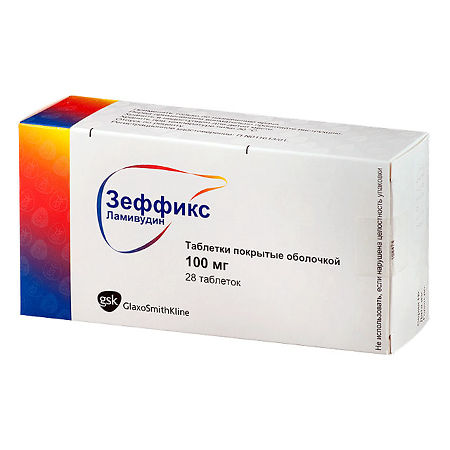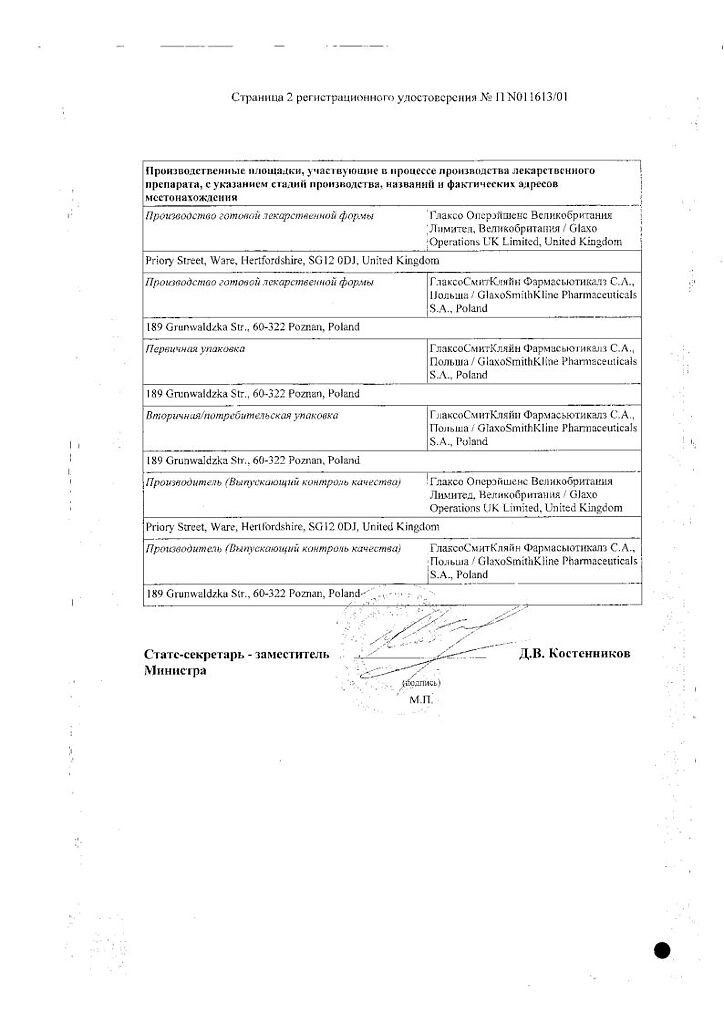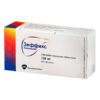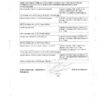No products in the cart.
Description
Zeffix is an antiviral drug.
It has high activity against hepatitis B virus (HBV).
In both infected and uninfected cells lamivudine is metabolized to lamivudine triphosphate, which is the active form of the drug. In vitro half-life of lamivudine triphosphate in hepatocytes is 17-19 h.
Lamivudine triphosphate is a substrate for DNA polymerase of hepatitis B virus. Incorporation of lamivudine triphosphate into viral DNA chain and subsequent chain breakage block further formation of viralDNA. Lamivudine is a weak inhibitor of mammalian α- and β-DNA polymerases.
In studies to determine possible effects on mitochondrial structure and DNA content and function, no significant toxic effects have been observed with lamivudine. Lamivudine has a very weak ability to reduce mitochondrial DNA content, is not normally incorporated into the mitochondrial DNA chain and does not inhibit mitochondrial DNA γ-polymerase.
Zeffix® has marked antiviral activity in vivo and rapidly suppresses HBV replication after initiation of treatment.
Pharmacokinetics
It is well absorbed from the gastrointestinal tract, bioavailability in adults after oral administration is usually 80-85%. When taken orally in therapeutic doses (100 mg once daily), Cmax is reached after approximately 1 h and is 1.1-1.5 mcg/ml.
Eating decreases Cmax (by 47%) and prolongs Tmax without changing the overall absorption of lamivudine (calculated based onAUC). When administered intravenously, the volume of distribution averages 1.3 L/kg.
In the therapeutic dose range, lamivudine has linear pharmacokinetics and binds only slightly to plasma proteins. According to limited data, lamivudine penetrates the CNS and the cerebrospinal fluid (2-4 h after oral administration, the ratio of concentrations in cerebrospinal fluid to serum is approximately 0.12).
It is slightly biotransformed in the liver. Systemic clearance of lamivudine averages about 0.3 L/h/kg. T1/2 is approximately 5-7 h. Most of lamivudine is excreted unchanged by the kidneys through glomerular filtration and active secretion (organic cation transport system). Renal clearance accounts for about 70% of lamivudine elimination.
Particular groups of patients
In patients with renal impairment the excretion of lamivudine is delayed (patients with Cl creatinine
Patients with hepatic impairment (not infected with HIV and HBV), tolerate lamivudine well. Impaired hepatic function does not affect the pharmacokinetics of lamivudine unless combined with renal impairment.
In elderly patients, age-related reduction in renal function has no significant effect on lamivudine excretion at creatinine Cl above 50 mL/min.
In late pregnant women, the pharmacokinetics of lamivudine after oral administration was similar to that of non-pregnant women.
The pharmacokinetics of lamivudine in children is not different from that in adults, but lamivudine clearance, adjusted according to body weight, is higher than in adults, which is expressed by a decrease in AUC. Clearance of lamivudine is highest in children at the age of 2 years and decreases by the age of 12 years, when its values become similar to those of adults.
The recommended dose for children from 2 to 11 years of age is 2 mg/kg once daily (up to a maximum of 100 mg/day), capable of providing comparable exposure to lamivudine to an adult dose (100 mg/day). There are few data on lamivudine pharmacokinetics in children younger than 2 years of age.
Indications
Indications
Chronic hepatitis B due to replication of the hepatitis B virus.
Pharmacological effect
Pharmacological effect
Zeffix is an antiviral agent.
It has high activity against the hepatitis B virus (HBV).
In both infected and uninfected cells, lamivudine is metabolized to lamivudine triphosphate, which is the active form of the drug. In vitro, the half-life of lamivudine triphosphate in hepatocytes is 17–19 hours.
Lamivudine triphosphate is a substrate for DNA polymerase of the hepatitis B virus. The inclusion of lamivudine triphosphate in the viral DNA chain and subsequent chain termination block further formation of viral DNA. Lamivudine is a weak inhibitor of mammalian α- and β-DNA polymerases.
In studies to determine the possible effect on mitochondrial structure, as well as on the content and function of DNA, lamivudine did not show significant toxic effects. Lamivudine has a very weak ability to reduce the content of mitochondrial DNA, is not, as a rule, included in the mitochondrial DNA chain and does not inhibit mitochondrial DNA γ-polymerase.
Zeffix® has significant antiviral activity in vivo and rapidly suppresses HBV replication after initiation of treatment.
Pharmacokinetics
Well absorbed from the gastrointestinal tract, bioavailability in adults after oral administration is usually 80–85%. When taken orally in therapeutic doses (100 mg 1 time per day), Cmax is achieved in approximately 1 hour and is 1.1–1.5 mcg/ml.
Food intake reduces Cmax (by 47%) and prolongs Tmax without changing the overall extent of lamivudine absorption (calculated based on AUC). With intravenous administration, the volume of distribution averages 1.3 l/kg.
In the therapeutic dose range, lamivudine has linear pharmacokinetics and is slightly bound to plasma proteins. According to limited data, lamivudine penetrates into the central nervous system and into the cerebrospinal fluid (2-4 hours after oral administration, the concentration ratio in the cerebrospinal fluid and serum is approximately 0.12).
Slightly biotransformed in the liver. The systemic clearance of lamivudine averages about 0.3 l/h/kg. T1/2 – approximately 5-7 hours. Most of lamivudine is excreted unchanged by the kidneys by glomerular filtration and active secretion (organic cation transport system). Renal clearance accounts for about 70% of lamivudine elimination.
Special patient groups
In patients with renal failure, the elimination of lamivudine from the body is slowed down (patients with creatinine Cl
Patients with liver failure (not infected with HIV and HBV) tolerate lamivudine well. Impaired liver function does not affect the pharmacokinetics of lamivudine unless combined with renal failure.
In elderly patients, age-related decline in renal function does not have a significant effect on the excretion of lamivudine when creatinine Cl is above 50 ml/min.
In women in late pregnancy, the pharmacokinetics of lamivudine after oral administration were similar to those in non-pregnant women.
The pharmacokinetics of lamivudine in children do not differ from those in adults, but the clearance of lamivudine, adjusted for body weight, is higher than in adults, which is reflected in a decrease in AUC. Lamivudine clearance is highest in children aged 2 years and decreases by 12 years, when its values become similar to those in adults.
The recommended dose for children from 2 to 11 years is 2 mg/kg 1 time per day (maximum up to 100 mg/day), which can provide lamivudine exposure comparable to the adult dose (100 mg/day). There are limited data on the pharmacokinetics of lamivudine in children under 2 years of age.
Special instructions
Special instructions
During treatment with Zeffix, patients should be regularly monitored by a physician experienced in the treatment of chronic hepatitis B.
Active ingredient
Active ingredient
Lamivudine
Composition
Composition
Active ingredient:
lamivudine 100 mg;
Excipients:
MCC;
sodium starch glycolate;
magnesium stearate;
hypromellose;
titanium dioxide;
macrogol 400;
polysorbate 80;
iron oxides yellow and red
Contraindications
Contraindications
Hypersensitivity to lamivudine or to any other component of the drug, pregnancy (first trimester).
With caution: should be used for renal failure, pancreatitis (including a history), peripheral neuropathy, pregnancy (II–III trimester), during lactation, in childhood (up to 2 years).
Side Effects
Side Effects
The most common side effects are general malaise and fatigue, respiratory tract infections, headache, discomfort and abdominal pain, nausea, vomiting and diarrhea.
The frequency of changes in laboratory parameters in patients with chronic hepatitis B is similar when using Zeffix® and placebo; the exception is a more frequent increase in ALT levels after completion of Zeffix® therapy. However, there was no significant difference in the incidence of increased ALT levels associated with increased bilirubin levels and/or signs of liver failure. It is unknown whether these cases of exacerbation of hepatitis are associated with treatment with Zeffix® or with the peculiarities of the course of chronic hepatitis itself.
Cases of pancreatitis and peripheral neuropathy (or paresthesia) have been observed in patients with HIV infection, but the association of these complications with lamivudine therapy has not been proven. There was no significant difference in the incidence of these complications in the groups of patients with chronic hepatitis B taking Zeffix® and placebo.
In patients with HIV infection receiving combination therapy with nucleoside analogues, cases of lactic acidosis have been reported, which is usually accompanied by severe hepatomegaly and fatty liver degeneration. There are isolated reports of the same side effects in patients with hepatitis B virus and liver failure; however, there is no data confirming the association of these complications with Zeffix®.
Interaction
Interaction
The likelihood of metabolic interaction of lamivudine with other drugs is low due to limited metabolism, low degree of binding to plasma proteins and excretion of the drug mainly by the kidneys in unchanged form.
The possibility of interaction of lamivudine with other drugs whose main mechanism of elimination is active renal secretion through the organic cation transport system, for example with trimethoprim, should be taken into account. Other drugs (eg ranitidine, cimetidine) are only partially eliminated by this mechanism and do not interact with lamivudine.
Drugs that are eliminated primarily by active organic anion transport or glomerular filtration do not appear to have clinically significant interactions with lamivudine.
Concomitant use of trimethoprim/sulfamethoxazole (co-trimoxazole) at a dose of 160 mg/800 mg leads to an increase in lamivudine exposure by 40% due to interaction with trimethoprim. However, in the absence of renal failure, there is no need to reduce the dose of lamivudine. Lamivudine does not affect the pharmacokinetics of trimethoprim and sulfamethoxazole.
With simultaneous use of lamivudine and zidovudine, a moderate (28%) increase in peak plasma concentrations of zidovudine was observed, but the area under the plasma concentration-time curve did not change significantly. Zidovudine does not have a clinically significant effect on the pharmacokinetics of lamivudine.
No pharmacokinetic interaction of lamivudine with α-interferon was observed when these drugs were used simultaneously. In patients simultaneously receiving Zeffix® and immunosuppressants (for example, cyclosporine A), clinically significant adverse interactions were not observed; however, no specific studies have been conducted. Lamivudine may inhibit intracellular phosphorylation of zalcitabine. Therefore, the concomitant use of lamivudine and zalcitabine is not recommended.
Overdose
Overdose
Symptoms: no specific symptoms of lamivudine overdose have been identified.
It is recommended to perform gastric lavage, administer activated charcoal, monitor the patient’s condition and carry out standard supportive therapy.
Continuous hemodialysis can be used to remove lamivudine, but no special studies have been conducted.
Storage conditions
Storage conditions
At a temperature not exceeding 30 °C
Shelf life
Shelf life
3 years
Manufacturer
Manufacturer
GlaxoSmithKline Pharmaceuticals S.A., Poland
Additional information
| Shelf life | 3 years |
|---|---|
| Conditions of storage | At a temperature not exceeding 30 °C |
| Manufacturer | GlaxoSmithKline Pharmaceuticals S.A., Poland |
| Medication form | pills |
| Brand | GlaxoSmithKline Pharmaceuticals S.A. |
Related products
Buy Zeffix, 100 mg 28 pcs. with delivery to USA, UK, Europe and over 120 other countries.













